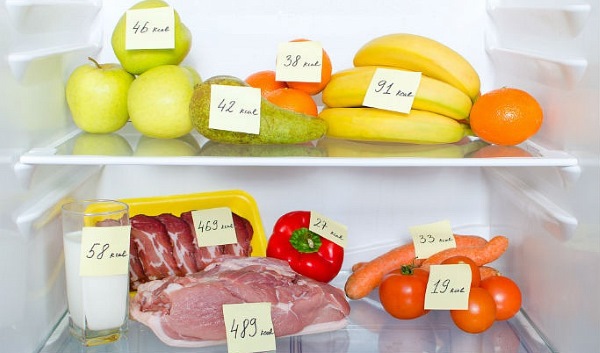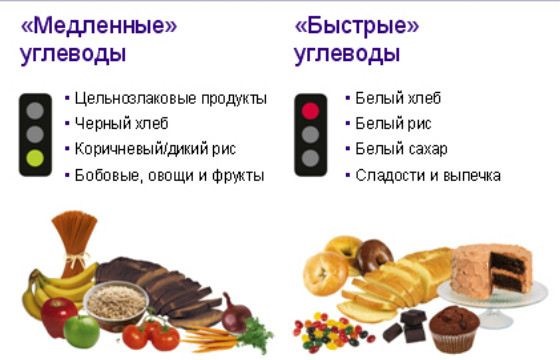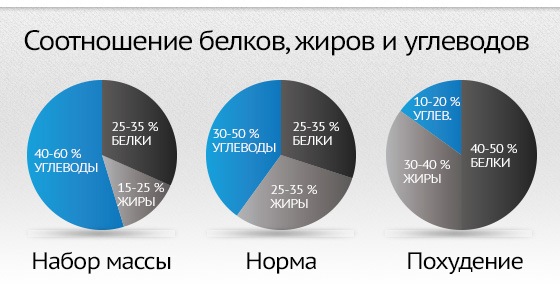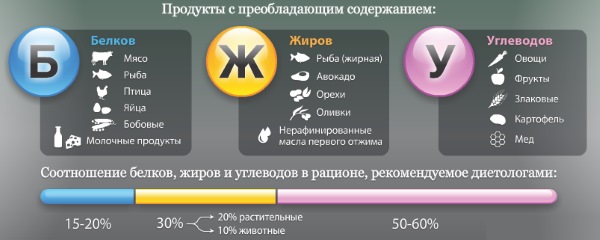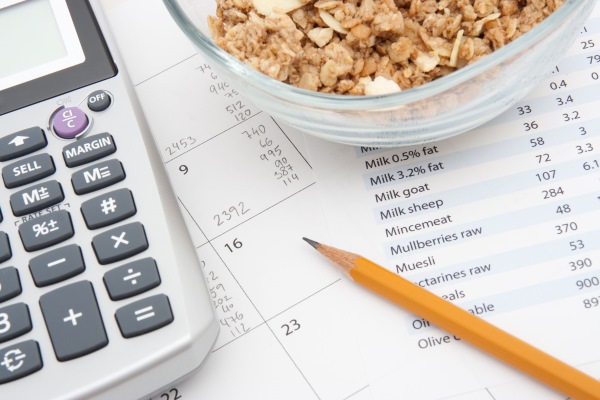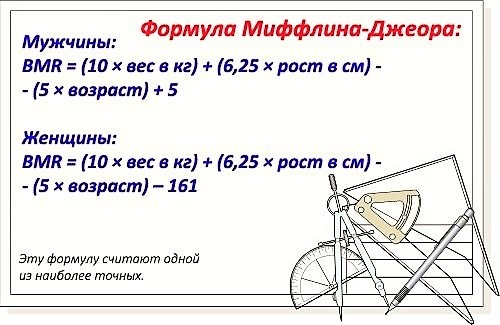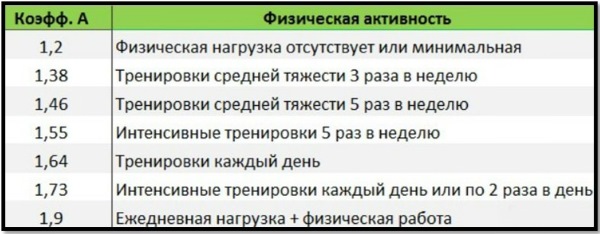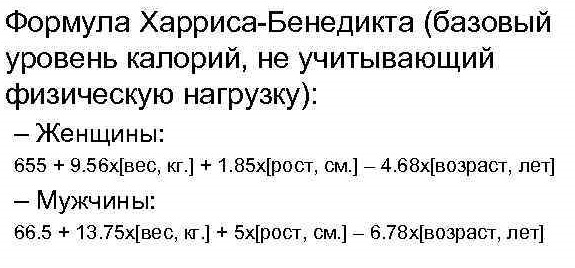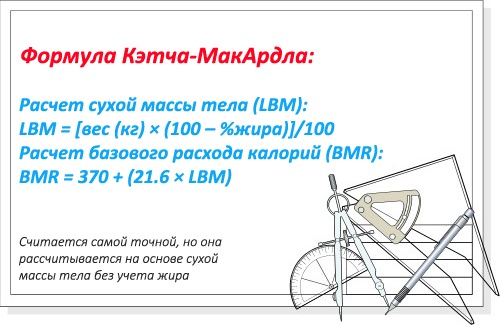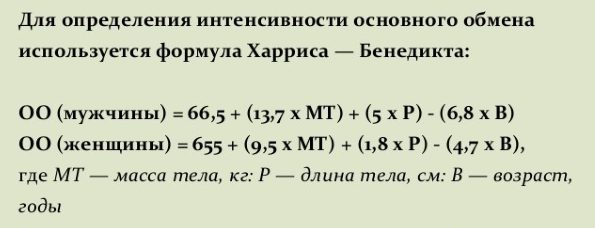The habit of maintaining a healthy weight requires responsibility and knowledge of metabolic processes. A conscientious person should understand how many calories and nutrients the body needs per day to be healthy. A table for calculating the daily calorie content and the ratio of BJU products will simplify this task.
What are kilocalories and BJU, their main tasks
Kilocalorie measures the amount of heat that is released from foods during digestion. One calorie equals 4.2 joules, a measure of energy level. The body spends this component on maintaining vital functions.
One unit of measure for heat gives the same amount of energy. Products differ in the ratio of BJU, and a different amount of energy is spent on the digestion of each of these components. Therefore, from the original calorie content, that part of the heat that the body loses during the breakdown of food is taken away.
Each element of the BJU body spends in its own way:
- Carbohydrates provide 4 kcal. Once in the metabolism, they are converted into glucose and raise blood sugar levels, which gives the body the energy to work. Most of this resource is extracted from food and consumed immediately. The body stores the rest in the form of fat.
- Proteins provide 4 kcal and are broken down to amino acids, which act as a tissue and muscle builder, and also deliver oxygen to cells. The body creates some of the components of this substance on its own. The body does not store protein and receives it only from food, the remains are excreted naturally.
- Fats provide 9 kcalare used to protect organs, provide energy and other bodily functions. The body constantly stores lipids and spends these reserves last.
How many kilocalories a person needs per day, the table with the volume of the diet shows approximately, but does not take into account the energy value of food. In order for the energy received by the body to be spent correctly, it is worth adhering to KBZHU.
Calorie content or balance of BJU: which is more important:
Healthy and unhealthy calories
Calories are not harmful or beneficial as they are simply a source of heat. This property is carried by energy carriers: fats, proteins and carbohydrates.
Each of these compounds is different in origin, and therefore affects the body specifically:
- Carbohydrates are classified as fast or slow. The former dramatically raise blood sugar, which provokes the body to store excess energy in fat reserves. The latter are digested for a long time due to their complex composition and are gradually consumed by the body. Fast carbohydrates include refined foods, and slow carbohydrates are foods high in fiber.
- Proteins are not harmful, however, their excess is harmful. Some foods containing amino acids contain harmful lipids and antibiotics. Not suitable for eating fatty meats.Vegetable protein has an inferior amino acid composition, so it is worth supplementing the menu with a complex of legumes and nuts.
- Fats are divided into saturated and unsaturated. The first type is useful for the body only conditionally, therefore it plays the role of a source of energy, which is consumed by the last, and therefore is deposited in a reserve. The body actively uses unsaturated fats to regulate the brain, replenish hormones, the protective functions of the skin and other means.
The ratio of BZHU is calculated individually for specific purposes. If the goal is to increase the percentage of muscle mass and reduce the fat reserve, a menu is selected in which proteins occupy the main place, and fats are not consumed at the same time as carbohydrates.
Standards for women, men and children
The table can show how many kilocalories a person needs per day more clearly. It should be taken into account that physical activity requires replenishment of the additional energy expended during training. In addition, more calories are expended on providing muscles in the daily routine.
| Group of persons | You need to consume calories per day |
| Children 6 months - 3 years | 800–1500 |
| Children 3-11 years old | 1500–2500 |
| Girls and boys 14-17 years old | 2700–3100 |
| Pregnant and lactating women | 3200–3500 |
| Athletes women and men | 4000–5000 |
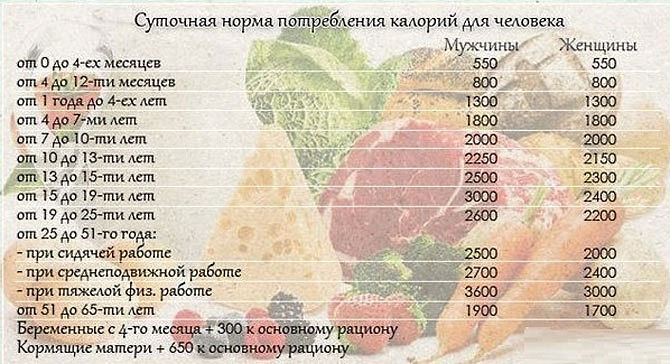
This difference between certain groups of people is justified by different physical activity. In addition, pregnant and lactating girls need to increase their diet in order to additionally provide the child with the necessary compounds, as well as to replenish the resources spent on this.
The calorie volume of women is slightly less than that of men. Age and work environment also affect the amount of energy expended:
| Women age in years / calorie intake | Men age in years / calorie norm | ||||
| 21–26 | 27–50 | >50 | 21–26 | 27–50 | > 50 |
| 1900 | 1700 | 1600 | 2400 | 2100 | 1800 |
Calorie intake is determined by many factors, as well as the ratio of BJU. For a more accurate calculation, you need to use one of the special formulas. And based on the results obtained, you can subsequently adjust your calorie intake.

 Don't miss the most popular column article: Fashionable haircut for short hair. Photo, front and back views.
Don't miss the most popular column article: Fashionable haircut for short hair. Photo, front and back views.Why stick to your daily calorie intake
Limiting the amount of food is the main rule of losing weight people. However, most of those who seek to lose weight, after a while, return to their previous shape, while looking fuller.
The body perceives a strong cut in calories as a mode of hunger, so it begins to burn muscles and slow down the metabolism.
When you return to the usual diet, the body quickly replenishes the lost resources and stores reserve fat in case of hunger. When calories are exceeded, the body also inevitably puts on excess weight.
Therefore, the only stable state in which the body does not make fat reserves and provides all its functions is to adhere to the daily calorie intake and balance of the BJU.
Lower limits of the norm
How many kilocalories a person needs per day can be shown in the table without taking into account individual characteristics that affect metabolism. Having made a calculation using special formulas, you can find out your daily calorie rate coefficient. Add 200 kilocalories to the result obtained, and then subtract 400.
These values are the upper and lower limits of the norm. Another way to calculate this data is to subtract or add 10-15% of calories to your base metabolism.
The range within these numbers is called the calorie corridor. This means that changes in daily caloric intake should not go beyond the normal range. Otherwise, the body will begin to slow down its metabolism and weight will cease to decrease, and energy will be extracted due to the destruction of muscle fibers.
Consequences of insufficient and excess calorie intake
At first, insufficient or excess calorie intake may not be apparent.
However, such a lifestyle systematically harms the body, which is why an accumulated habit can lead to such negative consequences:
- decreased immunity;
- eating disorders such as binge eating disorder;
- disturbances in the work of the gastrointestinal tract;
- oncology;
- disorders in mental and physical development.
In addition to the lack of calories in the diet, their excess gives rise to a lot of problems that lead to obesity and accompanying diseases:
- diabetes;
- diseases of the cardiovascular system;
- atherosclerosis;
- disorders in the work of the musculoskeletal system.
It should be understood that the ratio of the calorie intake for one person may be too high or too low for another. Only the amount of reserve fat can tell if the diet is right.
Muffin-Geor formula for calculating daily calories
The number of calories consumed during the day is selected for each individually, since age, height and weight play a role here. To do this, in 2005, scientists Muffin and Geor jointly developed a formula that takes these factors into account. Another method is approved by the American Dietetic Association.
In addition, an indicator of regular physical activity is added to the formula, which adds accuracy to the resulting calories.
You can calculate the daily value for women:
OOB = 9.9 * weight (kg) + height (cm) * 6.3 - 4.9 * age - 161,
and for men:
OOB = 9.9 * weight (kg) + height (cm) * 6.3 - 4.9 * age + 5.
Thus, the calculation for a woman with an age of 23 years, weighing 50 kg, and a height of 165 cm can be obtained: 9.9 * 50 + 165 * 6.3 - 4.9 * 23 - 161 = 1256 kcal. Likewise, a 26-year-old man, weighing 70 kg, 180 cm tall, will need 1535 kcal.
In this case, the component of physical activity must be taken into account. The resulting value is multiplied by the activity coefficient.
The minimum value for sedentary work is 1.2, and for heavy loads with training 2 times a day - 1.9. The level of physical activity in this range changes in increments of 0.1.
Harris-Benedict formula
The formula common for calculations was invented in 1991. However, the method is inferior in applicability to other methods. Against the background of other formulas, an insufficient number of individual characteristics is used here, which gives a strong error in calculations - more than 5%. The method does not take into account the indicator of daily physical activity in the calculations.
The formula looks like this:
Female gender: 655 + (9.5 * weight in kg) + (1.86 * height in cm) - (4.67 * age).
Male gender: 66.48 + (13.74 * weight in kg) + (5 * height in cm) - (6.75 * age).
Thus, a woman with indicators of 50 kg, 23 years old, 165 cm will have to consume 1332 kcal. A man with a baseline of 70 kg, 26 years old, 180 cm needs 1703 kcal to stay in his weight.
Ketch-McArdle Formula
This technique does not take into account body weight, number of years and growth rate in calculations. Only the individual body fat percentage is involved in the expression. The error in calculations based on this coefficient is large.
However, accurate measurements of body fat along with the use of the result of the Harris-Benedict formula in the calculations will give an indicator with a minimum error.
The Ketch - McArdle formula does not require complex calculations and looks like this:
- BM = 371 + 20.59 * a
The last variable refers to the percentage of body fat. It can be measured using special equipment found in hospitals and gyms.
Also, this indicator can be approximately calculated by dividing the weight in kilograms by the height in meters squared:
- body mass index (% fat) = weight (kg) / height (cm)2.
How many kilocalories a person needs per day, the data table for certain groups can predict with the same large error. However, multiplying the coefficient obtained from the Ketch-McArdle formula by the result of the calculation using the Harris-Benedict method will increase the measurement accuracy.
For women with parameters 50 kg, 165 cm and a diet of 1332 kcal, calculated according to the previous formula, the base metabolism will be equal to:
BM = 1332 * (371 + 21.61 * (50 / 1.652)) = 1021 kcal.
For men weighing 70 kg, height 170 cm and a daily norm of 1703 kcal:
BM = 1703 * (371 + 21.61 * (70 / 1.702) = 1521 kcal
This result is more accurate, however, the body weight without fat, calculated using the formula, is significantly inferior in error to measurements using special equipment.

 Don't miss the most popular column article: Fashionable haircut for medium hair. Photo, front and back views.
Don't miss the most popular column article: Fashionable haircut for medium hair. Photo, front and back views.WHO formula
The World Health Organization (WHO) Calorie Formula is based on the same principle as the Muffin-Geor Method. However, here the age is placed in the ranges and for each of them an individual calculation is carried out using the coefficient of physical activity (CFA).
How many kilocalories a person needs per day is determined using an additional table, taking into account the degree of load, where 1 is low, 1.3 is medium, 1.5 is high physical activity.
| Women | ALE | Men | ALE |
| 18-30 years old | (0.062 * weight + 2.0359) * 240 * CA | 18-30 years old | (0.063 * weight + 2.895) * 240 * CA |
| 31-60 years old | (0.034 * weight + 3.539) * 240 * CA | 31-60 years old | (0.484 * weight + 3.654) * 240 * CA |
| Over 60 years old | (0.038 * weight + 2.756) * 240 * CA | Over 60 years old | (0.491 * weight + 2.458) * 240 * CA |
A man with parameters 27 years old, 70 kg and CFA - 1.3 according to the formula has a coefficient:
(0.063 * 70 + 2.895) * 240 * 1.3 = 2279 kcal.
Body area formula
Another name for this method of calculating calories is the Harris-Benedict formula. With the help of such calculations, you can get the result that is as close to reality as possible. The expression contains indicators of weight, height and age, and for women and men different initial numbers are used in the calculations.
Body fat percentage is not included in the calculation. Therefore, this method will not show an accurate result for people who regularly play sports and have large muscle mass. In this case, the basal metabolic rate will be lower than the real one. For obese people, this value will be overestimated.
For men, the daily calorie intake is calculated using the formula:
OOB = 66 + (13.699 * weight in kg) + (5 * height in cm) - (6.809 * age in years).
And for women:
OOB = 65 + (9.599 * weight in kg) + (1.799 * height in cm) - (4.8 * age in years).
The daily calorie coefficient for a man with indicators of 70 kg, 170 cm, 27 years old is:
OOB = 66 + (13.699 * 70) + (5 * 170) - (6.809 * 27) = 1691 kcal.
For a woman with initial data 23 years old, weight 50 kg, height 165 cm, this indicator is equal to:
OOB = 65 + (9.599 * 50) + (5 * 165) - (6.809 * 23) = 1213 kcal.
In addition, the result obtained can be multiplied by the indicator of physical activity. For him, a range is proposed in which 1.2 is low mobility, 1.729 is hard physical labor.
How many calories should you eat to lose weight or gain weight
A significant exaggeration or understatement of volumes is always harmful to the body. It forces the body to destroy those resources that are necessary for healthy life and accumulate those that interfere with this process.
For a healthy transformation, the maximum output outside the calorie range of the diet is 10-20%.
When changing your diet, you need to weigh yourself at the beginning and end of the week and evaluate the result obtained. If the lost weight reaches more than 1-1.5 kg, then the body is losing weight due to dehydration and destruction of muscle cells to a greater extent than fat.
Weight loss rate
Losing weight by 2-3% of your current weight per week is considered safe by nutritionists. With large losses of mass, the body will begin to destroy itself and get energy from these substances. The largest plummet is observed at the beginning of the diet, subsequently its loss slows down.
It is important to understand that supplementing food with vigorous physical activity can cause weight loss. This is due to the accumulation of fluid in the muscles, as well as their growth. In this case, you need to observe the visual decrease in volumes.
Weight gain rate
There is a difference between intentional weight gain and uncontrolled eating. In the first case, this process is systemic and is used both for visual effect and as an introductory stage in the method of calculating calories. In these cases, muscle gain will be much slower.
With sharp deviations from the norm of calories upward, reserve fat will be deposited almost instantly.
However, with a gradual increase in the volume of the diet to its own norm in increments of 50 kcal, weekly weight gain will not be observed at all.
This is due to the fact that the body is gradually rebuilding its work for a new diet. However, with a calorie deficit, a sharp transition to a new nutrition system will lead to extra pounds.

 Don't miss the most popular column article: Fashionable bangs of the new season for medium, short, long hair. A photo.
Don't miss the most popular column article: Fashionable bangs of the new season for medium, short, long hair. A photo.Doctors and nutritionists' advice on keeping the right balanced menu
Medical experts assess the calorie counting method as a comprehensive, systematic approach to getting the desired weight. They recommend not to go beyond the boundaries of the calorie corridor, and also to support it by replacing the cooking method.
In addition, the junk food on which the calories are counted should be replaced with its healthy counterparts, and the calorie content of the diet in meals should be reduced by the end of the day.
Pregnant and lactating women should refrain from such a diet, as dietary restrictions can adversely affect their well-being. People with diabetes, hypertension and problems with the gastrointestinal tract need to enter such a diet only under the supervision of a doctor.
The main rule of adhering to a calorie-based diet is to avoid large gaps between meals.
At first, such calculations may seem complicated, however, over time, the selection method can be used to calculate the optimal amount of the ration. It must be remembered that without knowledge of how many calories a person needs per day and the table of the optimal ratio of BJU products, it is impossible to maintain the weight correctly. This method will also help improve your health and appearance.
Article design: Svetlana Ovsyanikova
Video on the topic: how many calories a person needs per day, table
How many calories a person needs per day:
How many calories do you need per day for weight loss:

